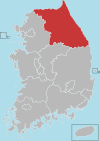Pyeongchang County
Pyeongchang (Korean pronunciation: [pʰʲʌŋ.tɕʰaŋ]; in full, Pyeongchang-gun [pʰʲʌŋ.tɕʰaŋ.ɡun]; English: /ˌpjʌŋˈtʃɑːŋ/[2]) is a county in the province of Gangwon-do, South Korea, located in the Taebaek Mountains region. It is home to several Buddhist temples, including Woljeongsa. It is about 180 km (110 mi) east southeast of Seoul, the capital of South Korea, and connected by expressways and high-speed passenger railways. Pyeongchang's slogan, "Happy 700 Pyeongchang", is taken from its average elevation of approximately 700 metres (2,300 ft).
Pyeongchang 평창군 | |
|---|---|
County | |
| Korean transcription(s) | |
| • Hangul | 평창군 |
| • Hanja | 平昌郡 |
| • Revised Romanization | Pyeongchang-gun |
| • McCune-Reischauer | P'yŏngch'ang-gun[1] |
.jpg) Alpensia Resort and a wind farm in Pyeongchang | |
 Emblem of Pyeongchang | |
| Etymology: 平 "peaceful" or "flatland", 昌 "prosperity" or "flourishing" | |
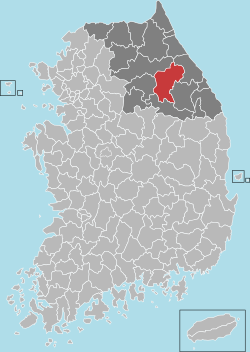 Location in Gangwon Province, South Korea | |
| Country | South Korea |
| Province | Gangwon-do |
| Administrative divisions | 1 eup, 7 myeon |
| Area | |
| • Total | 1,463.65 km2 (565.12 sq mi) |
| Population (2013) | |
| • Total | 43,666 |
| • Density | 30/km2 (80/sq mi) |
| • Dialect | Gangwon |
| Time zone | UTC+9 |
Pyeongchang hosted the 2018 Winter Olympics and the 2018 Winter Paralympics.[3] It was officially rebranded as "PyeongChang" (with a capital 'C') for the purposes of the 2018 Games, in order to avoid confusion with Pyongyang in North Korea.[4][5]
History
Pyeongchang region was ruled by the Goguryeo Dynasty during the Three Kingdoms period, and it was called Uk-o-hyeon (욱오현).[6] After the Silla dynasty conquered the Goguryeo Dynasty and Baekje Dynasty, it was renamed Baek-o-hyeon (백오현).[7]
After the Goryeo Dynasty was established, it renamed Pyeongchang-hyeon. Then, it was under control of Wonju.[8] When a 10-provincial system was enforced, the north of Pyeongchang region was involved in Sakbang-do, and the south of the region was involved in Jungwon-do. When a new administrative system was carried out by King Hyeonjong, the east of the region was involved in Dong-gyeo, and the rest of it was included in Yanggwang-do. An administrator for the region was sent from the central government, and it became independent of Wonju in 1299.[9]
When the Joseon Dynasty was founded in 1392, the region was promoted from a hyeon to a county (gun).[10] After the territory was divided into 8 Provinces under the reign of King Taejong, it was involved in Gangwon-do.[11] After the territory was divided into 23 districts in 1895 with the 8-provincial system abolished, it was included in Chugju-bu. When a 13-provincial system was enacted in 1896, it was involved in Gangwon-do.[12]
Geography
.jpg)
The altitude of Pyeongchang is wide-ranging, with 84% of its territory comprising mountains with average elevations of 750 m (2,460 ft).[13]
Its best-known place, the township of Daegwallyeong-myeon, averages between 700 and 800 m (2,300 and 2,600 ft) above sea level, with some areas over 1,000 m (3,300 ft) high.[14]
Climate
Pyeongchang County experiences a warm-summer humid continental climate (Köppen climate classification: Dwb).[15] Pyeongchang's winters are long and very snowy, while summers are relatively short.[16]
Average temperature of Pyeongchang from 2001 to 2010 was 7.0 °C, and it was lower than Gangwon's 8.9 °C. Annual precipitation of the region from 2001 to 2010 was 1,555.0 mm, and it was more than Gangwon's 1,491.5 mm.[17]
The warmest months of the year are July and August, with January and February being the coldest.
| Climate data for Daegwallyeong, Pyeongchang (1981–2010, extremes 1971–present) | |||||||||||||
|---|---|---|---|---|---|---|---|---|---|---|---|---|---|
| Month | Jan | Feb | Mar | Apr | May | Jun | Jul | Aug | Sep | Oct | Nov | Dec | Year |
| Record high °C (°F) | 8.7 (47.7) |
16.5 (61.7) |
19.7 (67.5) |
30.1 (86.2) |
31.0 (87.8) |
32.3 (90.1) |
32.9 (91.2) |
32.7 (90.9) |
29.0 (84.2) |
24.7 (76.5) |
21.5 (70.7) |
13.5 (56.3) |
32.9 (91.2) |
| Average high °C (°F) | −2.5 (27.5) |
−0.4 (31.3) |
4.4 (39.9) |
12.9 (55.2) |
17.6 (63.7) |
20.5 (68.9) |
22.8 (73.0) |
22.8 (73.0) |
18.6 (65.5) |
14.0 (57.2) |
7.0 (44.6) |
0.5 (32.9) |
11.5 (52.7) |
| Daily mean °C (°F) | −7.7 (18.1) |
−5.5 (22.1) |
−0.5 (31.1) |
7.0 (44.6) |
11.9 (53.4) |
15.7 (60.3) |
19.1 (66.4) |
19.1 (66.4) |
14.1 (57.4) |
8.3 (46.9) |
1.3 (34.3) |
−4.4 (24.1) |
6.6 (43.9) |
| Average low °C (°F) | −12.6 (9.3) |
−10.5 (13.1) |
−5.2 (22.6) |
1.2 (34.2) |
6.3 (43.3) |
11.2 (52.2) |
16.0 (60.8) |
16.1 (61.0) |
10.0 (50.0) |
3.1 (37.6) |
−2.8 (27.0) |
−9.1 (15.6) |
2.0 (35.6) |
| Record low °C (°F) | −28.9 (−20.0) |
−27.6 (−17.7) |
−23.0 (−9.4) |
−14.6 (5.7) |
−4.7 (23.5) |
−1.7 (28.9) |
4.4 (39.9) |
3.3 (37.9) |
−2.3 (27.9) |
−9.9 (14.2) |
−18.7 (−1.7) |
−24.7 (−12.5) |
−28.9 (−20.0) |
| Average precipitation mm (inches) | 62.6 (2.46) |
53.6 (2.11) |
75.6 (2.98) |
89.5 (3.52) |
122.3 (4.81) |
201.0 (7.91) |
326.7 (12.86) |
420.9 (16.57) |
307.3 (12.10) |
124.9 (4.92) |
76.9 (3.03) |
36.8 (1.45) |
1,898 (74.72) |
| Average precipitation days (≥ 0.1 mm) | 10.5 | 10.5 | 11.3 | 9.5 | 11.1 | 13.2 | 17.6 | 17.8 | 13.0 | 8.7 | 10.1 | 9.4 | 142.7 |
| Average snowy days | 13.0 | 11.8 | 12.0 | 3.3 | 0.2 | 0.0 | 0.0 | 0.0 | 0.0 | 0.8 | 5.2 | 10.9 | 57.2 |
| Average relative humidity (%) | 67.3 | 67.0 | 67.5 | 61.0 | 68.4 | 79.2 | 85.7 | 87.0 | 84.6 | 75.2 | 69.9 | 67.3 | 73.3 |
| Mean monthly sunshine hours | 197.2 | 185.2 | 202.3 | 226.6 | 229.4 | 179.8 | 138.1 | 130.7 | 143.9 | 193.3 | 176.4 | 191.9 | 2,194.8 |
| Percent possible sunshine | 64.4 | 60.8 | 54.6 | 57.4 | 52.1 | 40.7 | 30.8 | 31.0 | 38.6 | 55.5 | 57.8 | 64.3 | 49.3 |
| Source: Korea Meteorological Administration[18][19][20] (percent sunshine and snowy days)[21] | |||||||||||||
Culture and tourism

Cultural heritage sites
In Pyeongchang, 16 heritage sites were registered by the South Korean government, and 45 Heritages were registered by the Gangwon Provincial Office.
The count of cultural heritage designations is as follows.
- Registered by the Nation: 5 National Treasures, 5 Treasures, 1 Historic Site, 3 Natural Monuments, 1 National Folklore Cultural Heritage, 1 Registered Cultural Heritage
- Registered by the local government: 29 Tangible Cultural Heritages, 2 Intangible Cultural Heritages, 4 Monuments, 10 Cultural Heritage Materials
Temples
Sangwansa is a temple on Odaesan Mountain that was originally established as Jinyeowon in 705. Although the Joseon Dynasty's policy was the prohibition of Buddhism, it constantly donated to rebuild the temple. In 1401, King Taejong donated to the construction of Sajaam Hermitage. In 1465, King Sejo and administrators donated to rebuild the temple.[22] Sejo's son, King Yejong designated it as a memorial for his father. During the Third Battle of Seoul, the United Nations Command ordered that the temple be burned, but a Buddhist monk prevented it. Instead, the Command agreed to burn only the doors of the temple.[23]
Sangwonsa has the following cultural heritage sites:
- The Bell of Sangwonsa (National Treasure No. 36)
- Promotion of Virtue for Rebuilding Sangwonsa (National Treasure No. 292)
- Wooden seated figure of the Manjusri Child in Sangwonsa (National Treasure No. 221)
- Wooden seated figure of the Manjusri Child's Enshrined Heritages in Sangwonsa (Treasure No. 793)
- Wooden seated figure of Manjusri and its Enshrined Heritages in Sangwonsa (Treasure No. 1811)
- Wooden sedentary figure of Manjusri's Enshrined Classical Kooks in Sangwonsa (Treasure No. 1812)
Woljeongsa is a temple on Odaesan Mountain established by Jajang the monk in 643. After it was established, it was consistently rebuilt. During the Third Battle of Seoul, 10 buildings were totally destroyed by fire. Tanheo the monk restored Jeokgwangjeon, one of the burnt buildings, in 1964, and Manhwa the monk gradually reconstructed other buildings.[24]
Woljeongsa has the following cultural heritage sites:
- Octagonal Nine-story Stone Pagoda of Woljeongsa (National Treasure No. 48-1)
- Reliquaries of the Octagonal Nine-story Stone Pagoda of Woljeongsa (Treasure No. 1375)
- Stone seated figure of the Bodhisattva in Woljeongsa (National Treasure No. 48-2)
- Painting of Three Bodhisattvas originated from Wonju Guryongsa (Treasure No. 1855) (Placed in Wolljeongsa, possessed by Guryongsa)
- Clothes of the Buddhist monk Han-am (Registered Cultural Heritage No. 645)
Historic sites
The Pyeongchang Odaesan Historic Archive (Historic Site No. 37) was one of five archival locations in the latter part of the Joseon Dynasty for the Annals of the Joseon Dynasty and Sonwon-kyebo-kiryak.
Festivals
- Daegwallyeong Snow Festival
- Daegwallyeong Snow Festival began as "Daegwallyeong Winter Snow Festival" in 1992 by Daegwallyeong Ski Club. In 1993, the first festival was formally held. Events of the 1st festival were skiing competition for locals, games of making snowmen, snow sledge competition, and sledge competition. Some games were added to next festivals, such as traditional games and snow car raising. [25]
- On 7–22 Feb 2018, 26th festival was held in hwenggye-ri, Daegwallyeong-myeon as a pre-event of the 2018 Winter Olympics. Events include an exhibition of snow figures, snow sledge competition, international naked marathon, traditional folk performances, and Hwangbyoungsan Mountain hunting game.[26]
- Hyoseok Cultural Festival
- Pyeongchang is the hometown of Lee Hyo-seok, a Korean novelist,[27] and this festival is held in Lee Hyo-seok Culture Village, where he grew up.[28]
Museum
- The Lee Seung-bok Memorial Hall is located in Nodong-ri, Yongpyeong-myeon to memorialize Lee Seung-bok who was a South Korean boy murdered by North Korean commandos in 1968. It was established in 1982, with building a memorial statue for Lee. Lee's house was restored in 2000.[29]
Tourism
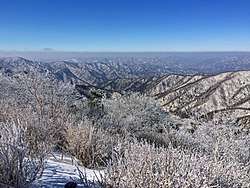
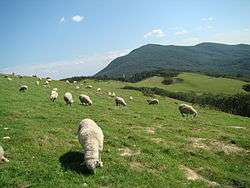
Odaesan Mountain is the home of historical Buddhist temples including Sangwonsa and Woljeongsa.[30] It was designated as a national park in 1975. The highest peak, Birobong Peak is 1,563 m (5,128 ft) high.[31]
Two major ski resorts in the county were the home of the 2018 Winter Olympics. Alpensia ski resort has six slopes for skiing and snowboarding, with runs up to 1,400.0 m (4,593.2 ft) long, for beginners and advanced skiers, and an area reserved for snowboarders. The resort is open year-round.[32] Alpensia hosted the majority of the Olympic snow events.[33] Yongpyong Resort, which has a total of 28 ski slopes, hosted the technical alpine skiing events.[34]
Alpensia will be the focus of the 2018 Cultural Olympiad, with a new, purpose-built concert hall within the resort with an indoor water park.[35]
Samyang Ranch is the largest highlands farm in Asia, located in the hills of Daegwallyeong at 850 to 1,470 meters above sea level. It is operated as a petting zoo and features a pastoral landscape. The ranch is operated by the leading Korean food and dairy company Samyang food, the first company to introduce ramyeon instant noodles into a poverty-ridden South Korea in the 1960s. It is the filming location of the drama Autumn in My Heart and the movie Lover’s Concerto.[36]
Sport
Pyeongchang hosted the 1999 Asian Winter Games and 2013 Special Olympics World Winter Games. The 2018 Winter Olympics were held in Pyeongchang. The 2009 IBU Biathlon World Championships were also held there.
1999 Asian Winter Games
The Asian Winter Games was held in 1999 in Gangwon Province including Pyeongchang. Originally, it hoped to host the 3rd Asian Winter Games, which North Korea gave up; however, Harbin was announced to host the 3rd Games. It was decided that Gangwon would host the 4th Asian Winter Games at the same time.[37]
Total 799 athletes participated in the Games. Alpine skiing, cross-country skiing, biathlon, short track speed skating, and figure skating events were held in Pyeongchang.[38]
2018 Winter Olympic Games
.jpg)
On 6 July 2011, Pyeongchang was announced to host the 2018 Winter Olympics and the 2018 Winter Paralympics. The other candidates were Annecy, France and Munich, Germany. It is the third Winter Games in Asia after the 1972 games in Sapporo, Japan and the 1998 games in Nagano, Japan. It also is the first Asian locality to host the Winter Games outside Japan. Pyeongchang won their 2018 bid after two previous failed attempts for the 2010 and 2014 Winter Olympics, in which it lost to Vancouver, Canada, and Sochi, Russia, respectively.[39]
For the 2018 Olympics, Pyeongchang is being marketed with the CamelCase spelling of "PyeongChang", so the global audience does not confuse it with Pyongyang, the capital of neighboring North Korea.[40] Two main facilities for the 2018 Winter Olympics were the PyeongChang Olympic Plaza (where the opening / closing ceremonies and victory ceremonies were held) and the Gangneung Olympic Park (where the men's and women's short track, speed skating, figure skating, ice hockey, curling events were held).[41] The 2018 Winter Paralympics was held in the same venues starting March 9, 2018.[42]
Olympic venues and Dream Program
In preparation for the 2018 Olympics, the region has built facilities including hotels and a world-class ski resort, named Alpensia.
The region is implementing its so-called 2018 Dream Program, a legacy of the 2010 bid. It has mounted its fifth sports and cultural program, involving 124 participants from 31 countries, who were invited because they live where there is no snowfall and have no opportunity to participate in winter sports.[43]
Transportation
Pyeongchang County is traversed from west to east by the Gyeonggang Line and Yeongdong Expressway. The railway and expressway both originate in the Seoul metropolitan region.
Trains
A new KTX line, named the Gyeonggang Line, was built between Wonju and Gangneung via Pyeongchang for the 2018 Winter Olympics, connecting Pyeongchang to Seoul with a journey time of less than 80 minutes. The new line, which was officially opened on 22 August 2017, provides a main-line high-speed rail service that passes through Pyeongchang from west to east, with KTX trains calling at Pyeongchang Station and Jinbu Station (for the Olympic Stadium).[44] KTX trains to Jinbu Station were increased for the duration of the 2018 Olympics.[45]
Buses
- Intercity Buses
Pyeongchang Bus Terminal and Jangpyeong Bus Terminal, Jinbu Bus Station and Hoenggye Bus Station are the main intercity bus terminals of the county. Daehwa Bus Station is also served by intercity buses.[46]
- Transit buses
Local transit operators connect communities in the county to hubs at Pyeongchang Bus Station, Jangpyeong Bus Terminal, and Jinbu Bus Station.
Road
Yeongdong Expressway passes through Pyeongchang from west to east. After the expressway was expanded in 1999 for the Winter Asian Games, it takes about two hours from Seoul to Pyeongchang by car.[47]
50  |
E.Dunnae IC ↔ Myeonon IC ↔ Pyeongchang IC ↔ Soksa IC ↔ Jinbu IC ↔ Daegwallyeong IC↔ Gangneung JC | |||||||||||||
|---|---|---|---|---|---|---|---|---|---|---|---|---|---|---|
Pyeongchang County is traversed from west to east by National Routes 6 and 42; National Routes 31 and 59 pass through from north to south.
Administrative divisions
The district includes one town (eup), Pyeongchang-eup (평창읍; 平昌邑) and seven townships (myeon):
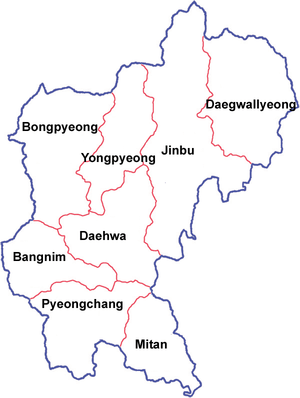 |
|
References
- "P'yŏngch'ang-gun: South Korea - name, geographic coordinates, administrative division, and map". Geographical Names. Retrieved 8 July 2011.
- "AAJA MediaWatch on Pyeongchang Pronunciation". Retrieved 16 February 2018.
- "S. Korean city to host 2018 Winter Olympics". CNN. 6 July 2011. Retrieved 6 November 2011.
- Swalec, Andrea (28 November 2017). "Pyeongchang? Pyongyang? Olympic Host City Location Is Easily Mistaken". NBC4 Washington. Washington. Retrieved 15 February 2018.
- Keating, Josh. "Pyongchang vs. PyeongChang vs. Pyeongchang". Slate. Retrieved 23 February 2018.
- 관동대학교영동문화연구소(평창군지편찬위원회), 평창군지 상, Pyoengchang County, 2003, pp. 48–49
- 관동대학교영동문화연구소(평창군지편찬위원회), 평창군지 상, Pyoengchang County, 2003, p. 61
- Goryeosa. 1455.
- 관동대학교영동문화연구소(평창군지편찬위원회), 평창군지 상, Pyoengchang County, 2003, p. 75
- "연혁". happy700.or.kr.
- "강원도 역사와 문화". www.provin.gangwon.kr.
- "Pyeongchang Culture & Tourism – History". eng.pc.go.kr.
- "VI. Environment and meteorology - Geographic Characteristics of PyeongChang and its Vicinity" (PDF). Archived from the original (PDF) on 29 August 2011. Retrieved 8 July 2011.
- "Pyeongchang, Korea". Gamesbids.com. 2 August 2007. Retrieved 7 July 2011.
- Peel, M. C.; Finlayson B. L. & McMahon, T. A. (2007). "Updated world map of the Köppen−Geiger climate classification" (PDF). Hydrol. Earth Syst. Sci. 11 (5): 1633–44. doi:10.5194/hess-11-1633-2007. ISSN 1027-5606.
- 관동대학교영동문화연구소(평창군지편찬위원회), 평창군지 상, Pyoengchang County, 2003, p. 289.
- 기상청; 강원지방기상청 (2016). "강원도 평창군 기후변화 상세 분석보고서" (PDF).
- "평년값자료(1981–2010), 대관령(100)" (in Korean). Korea Meteorological Administration. Retrieved 7 December 2016.
- "기후자료 극값(최대값) 전체년도 일최고기온 (℃) 최고순위, 대관령(100)" (in Korean). Korea Meteorological Administration. Retrieved 27 July 2018.
- "기후자료 극값(최대값) 전체년도 일최저기온 (℃) 최고순위, 대관령(100)" (in Korean). Korea Meteorological Administration. Retrieved 27 July 2018.
- "Climatological Normals of Korea" (PDF). Korea Meteorological Administration. 2011. pp. 499, 649. Archived from the original (PDF) on 7 December 2016. Retrieved 7 December 2016.
- 평창 상원사 중창권선문 [Promotion of Virtue for Rebuilding Sangwonsa (National Treasure No. 292 of South Korea )]. (in Middle Korean). 1464.
- 한국학중앙연구원. 한국민족문화대백과사전, 상원사. 한국학중앙연구원.
- 한국학중앙연구원. 한국민족문화대백과사전, 월정사. 한국학중앙연구원.
- 관동대학교영동문화연구소(평창군지편찬위원회), 평창군지 상, Pyoengchang County, 2003, pp. 385–87.
- "대관령눈꽃축제 소개". 대관령축제위원회 (in Korean). Retrieved 9 February 2018.
- 한국학중앙연구원. 한국민족문화대백과사전, 이효석. 한국학중앙연구원.
- "이효석문화마을". visitkorea (in Korean). Retrieved 10 February 2018.
- 관동대학교영동문화연구소(평창군지편찬위원회), 평창군지 상, Pyoengchang County, 2003, p. 384.
- 한국학중앙연구원. 한국민족문화대백과사전, 오대산. 한국학중앙연구원.
- "Odaesan National Park (오대산국립공원)". visitkorea.or.kr. Korea Tourism Organization.
- "Gangwon-do » Pyeongchang-gun » Alpensia Resort". Korean Tourism Organization. Retrieved 9 July 2011.
- "올림픽의 감동! 설레는 질주해볼까|1. 알펜시아 리조트". 10 January 2018.
- "올림픽의 감동! 설레는 질주해볼까|2. 용평리조트". 10 January 2018.
- "Press Release: PyeongChang 2018 boosts cultural Olympiad plan with new Alpensia concert hall (SportsFeatures.com)". PyeongChang 2018 Bid Committee. 23 July 2010. Archived from the original on 18 March 2012. Retrieved 9 July 2011.
- "Pyeongchang, nature's playground – Tourist Sites". visitkorea. Retrieved 7 December 2014.
- 관동대학교영동문화연구소(평창군지편찬위원회), 평창군지 상, Pyoengchang County, 2003, p. 777
- 관동대학교영동문화연구소(평창군지편찬위원회), 평창군지 상, Pyoengchang County, 2003, p. 778
- "Pyeongchang named as host city for 2018 Winter Olympics". Daily Telegraph. 6 July 2011. Retrieved 7 July 2011.
- "Olympics: 2018 Winter Olympics … not in Pyongyang". Manila Bulletin. Agence France-Presse. 26 January 2016. Retrieved 26 January 2016.
- "The PyeongChang 2018 Olympic and Paralympic Winter Games". www.pyeongchang2018.com. Archived from the original on 12 February 2018. Retrieved 25 February 2018.
- "The PyeongChang 2018 Olympic and Paralympic Winter Games". www.pyeongchang2018.com. Archived from the original on 8 March 2018. Retrieved 25 February 2018.
- "Pyeongchang Gets into Position for 2018 Olympic Winter Games Bid". Gamesbids.com. Retrieved 7 July 2011.
- "경강선, 22일 정식 개통…KTX로 청량리서 강릉까지 86분" [Steel wire, 22 days officially opened ... 86 minutes from Kangwon-ri to Gangneung by KTX]. The Chosun Ilbo. 22 December 2017.
- Bureau of railroad operation, MOLIT. "서울~강릉 KTX 올해말 개통, 114분 소요" (Press release) (in Korean). Ministry of Land, Infrastructure and Transport, South Korea. Retrieved 9 February 2018.
- Pyeongchang county Office. "시외버스안내" [Intercity Bus Information] (in Korean). Retrieved 9 February 2018.
- 관동대학교영동문화연구소(평창군지편찬위원회), 평창군지 상, Pyoengchang County, 2003, pp. 589–90.
External links
| Wikimedia Commons has media related to Pyeongchang. |
| Wikivoyage has a travel guide for Pyeongchang. |
- Pyeongchang County government website (in English)
- Pyeongchang 2018 website (in English)
